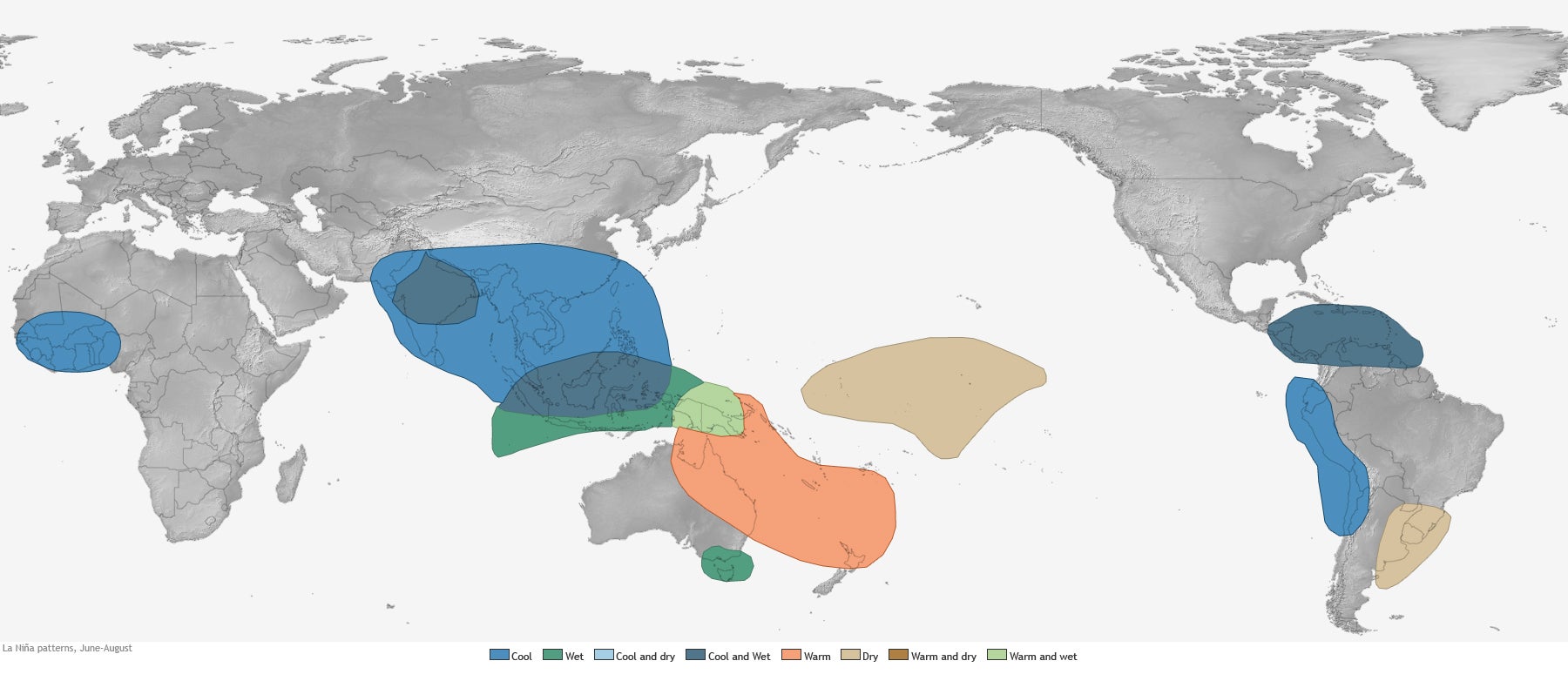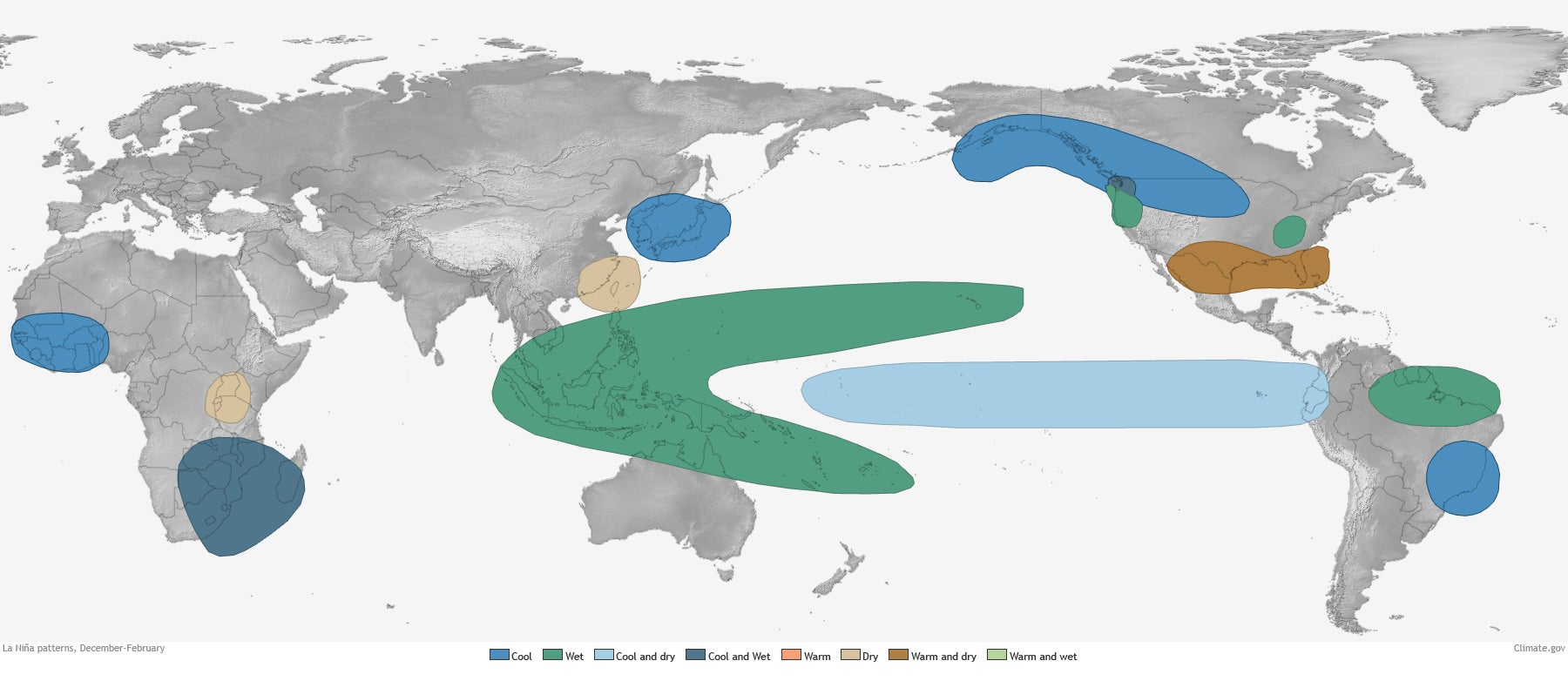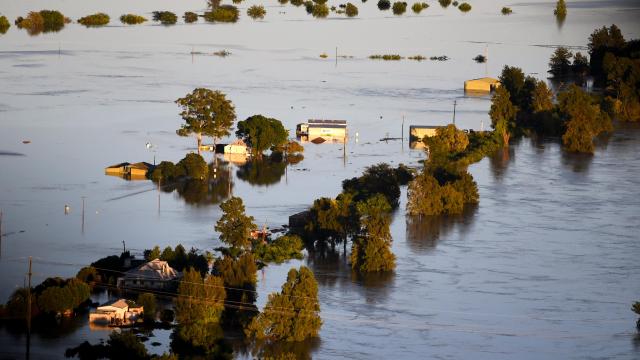A shutdown of a major current in the Atlantic Ocean would rapidly transform wind, temperature, and precipitation patterns across the whole globe, according to new research.
The current is already slowing, likely at least in part because of human-caused climate change. Now, scientists have found that, if the Atlantic Meridional Overturning Circulation (AMOC) collapses completely, there would be never-before-predicted impacts, according to a study published last week in the journal Nature Climate Change.
The researchers determined that, without the AMOC, the tropical Pacific Ocean cools, and trade winds intensify and shift south. The resulting climate state would resemble a permanent La Niña and could trigger catastrophic monsoons and flooding in the South Pacific, along with increased drought and heat in parts of North America.
In other words: If human actions make the AMOC run amok, the ensuing climate chaos would be even worse and weirder than previously expected.
What is the AMOC?
The Atlantic Meridional Overturning Circulation is a critical pattern of flow that moves warmer water from farther south into the North Atlantic Ocean. It transports carbon, nutrients, and heat — helping to fuel fisheries and regulate Europe’s mild climate. The AMOC is why London is very close in latitude to L’Anse-au-Loup in Canada’s Newfoundland and Labrador but has an average January temperature that’s 39 degrees Fahrenheit warmer.
AMOC’s conveyer belt is driven by gradients of heat and salty-ness in the ocean. Differences in density push water around. As ice melts or the oceans freeze, the relative temperature and salinity of water changes, and so currents do, too. The AMOC has shifted throughout Earth’s history and, at times in the distant past, has even halted.
The last time the AMOC slowed to a near stop was about 14,500 years ago, toward the end of the last ice age, as the planet began to warm. When that happened, the Northern Hemisphere was catapulted back into cold conditions for another 3,000 years.
What’s happening to the AMOC now?
Past research has shown that the critical current has slowed by about 15% since the 1950s, at least in part because of oceanic and atmospheric shifts wrought by human-caused climate change. Since the flow is so crucial for our climate’s stability, the possible collapse of the current is considered a major “tipping point,” or an irreversible and worrying threshold, among climate scientists.
Yet just because the AMOC is slowing, doesn’t mean its collapse is imminent. One recent study published in April (also in Nature Climate Change) concluded the current is less sensitive to ice melt and influxes of freshwater than previously thought. Even under the worst-case emissions scenarios, the 2014 5th IPCC report projected the AMOC will only slowdown by about one-third — not fully stop — by 2100. Scientists have emphasised that other major climate tipping points are much closer to happening within our lifetimes, like the Amazon Rainforest’s pending ecological failure.
It may be a poor consolation, but before you become super-anxious about a sudden Day After Tomorrow-type scenario, know that there are more pressing apocalyptic benchmarks to focus on.
But what happens if the AMOC does collapse?
So, that big caveat aside: What happens if the ocean’s current conga line hits a wall after all? The new study offers a fuller portrait of that possible but unlikely future.
From past research, we already know that without the AMOC, the Northern Hemisphere and most of the Atlantic Ocean gets a lot colder, and sea ice expands. This new study reaffirms that and projects that some sections of the North Atlantic and coastal Europe would experience average temperature drops of more than 15 degrees Celsius, or 27 degrees Fahrenheit, over the course of a few decades.
According to the researchers’ models though, the collapse of AMOC wouldn’t just mean changes in the Atlantic Basin or the Northern Hemisphere — but rather an abrupt and worldwide shift in climate everywhere. In a tweet thread, Matthew England, one of the study authors, broke down the results with a wild-looking map.
In this study, we demonstrate the potential for far-reaching effects, including AMOC teleconnections to adjacent basins and into the Southern Hemisphere. It all starts with a build-up heat just south of the Equator in the Atlantic…. pic.twitter.com/L7U4Tqx9N0
— Prof. Matt England (@ProfMattEngland) June 6, 2022
The northern Pacific Ocean would cool. Patches of the Northern Hemisphere would get drier, while patches of the South become wetter. Atmospheric pressure would shift to be much higher over Eurasia and other parts of the Northern Hemisphere. Trade winds from the north would move farther south and get stronger. Other winds elsewhere would also intensify. Antarctic ice could melt even faster.
In short: all the basics about the planet we know and love get thrown way out of whack. No corner of Earth is forecast to be unaffected by an AMOC collapse in the new research.
“A collapse of the Atlantic overturning circulation has global climate impacts,” study author Byram Orihuela-Pinto told Gizmodo in an email. Orihuela-Pinto is currently an oceanography PhD candidate at the University of New South Wales in Sydney, Australia. An AMOC collapse “alters the tropical Pacific ocean currents and winds in a way that resembles a La Niña mean state,” he continued.
The weather phenomenon La Niña is the converse to El Niño. Both have global effects and are caused by patterns of ocean surface temperature that alter atmospheric pressure. The fluctuations generally occur every two to seven years. When La Niña happens, temperatures drop and rainfall increases across regions, including parts of the South Pacific, southern China, and India. At the same time, among other impacts, a swathe of the southern U.S. becomes warmer and dryer.
Some of the worst flooding in Australia’s history has been linked to La Niña, as has the historic, catastrophic, ongoing California drought.


Once again, though, I am here to remind you not to (totally) freak out. “This is not a projection study, but a what-if scenario. The AMOC is slowing down, it is projected to slow further, and our work [only] looks at what this might mean for global climate if the current collapses altogether,” wrote Orihuela-Pinto. Nothing that he and his colleagues found is guaranteed (or even particularly likely) to happen, especially if we work to mitigate climate change.
Its also important to note that the researchers relied on models to come to their “what-if” conclusions. As with all model-based studies, there are big limits to what this research can tell us on its own and how definitive the results are.
Their modelling methods are robust and in line with previous work, said Feng He, a climate scientist at the University of Wisconsin-Madison who is uninvolved in the new study, in an email to Gizmodo. But, “the lack of data verification makes this paper less convincing.”
There are a lot of indicators in Earth’s paleo record that can be used to help reconstruct what past regional climates were like when the AMOC was much slower. Feng He pointed out that this study doesn’t double-check the model’s results by comparing them to that record. “I would like to see more studies to confirm this finding, as we have extensive proxy data during the past when AMOC was believed to be much weaker.”
So, we should look to the past to get a better grip on our potential future. How far back we have to look, though, depends on how far we let climate change go.
